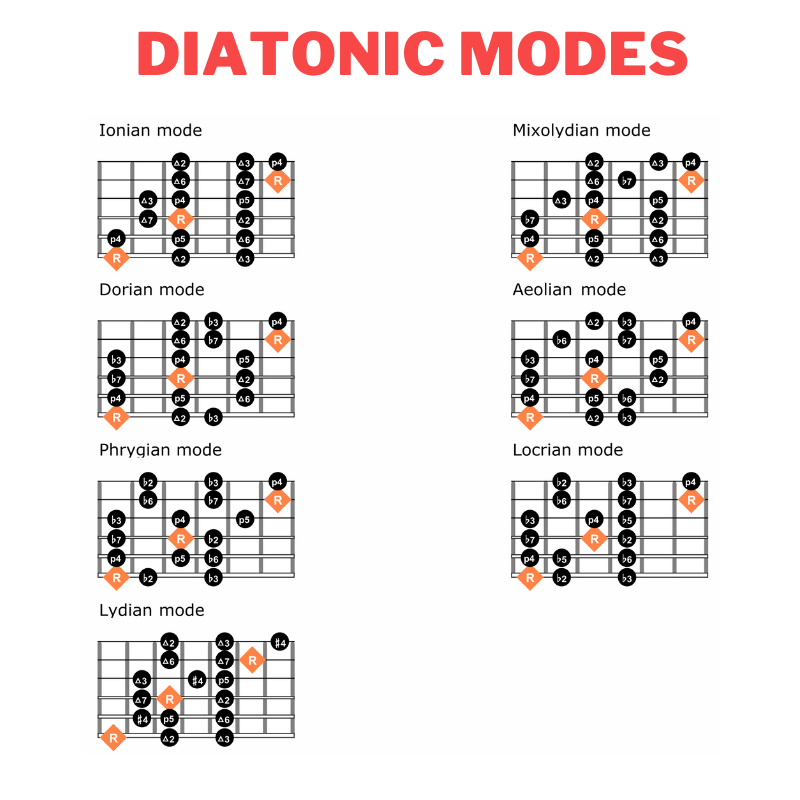Unlocking the Power of Guitar Modes
When learning lead guitar, there’s a good chance you’ve heard mysterious words like Dorian or Phrygian tossed about by other players. Maybe you’ve looked at a modal chart and thought: What the hell am I meant to do with that? If so, you’re not alone. This page will demystify guitar modes by using one of the most useful visual tools available: the fretboard.
We'll focus on the 7 modes of the major scale, starting with Ionian and working through Dorian, Phrygian, Lydian, Mixolydian, Aeolian, and Locrian. This lesson assumes you already know how to play a major scale in at least one position.

🎼 What is a Mode?
In simple terms: a mode is just a scale — but starting from a different note of the major scale. Think of it as rearranging the same 7 notes in a different order. The notes stay the same, but the flavour and mood of the music shifts based on where you begin.
For example:
-
C Major Scale: C D E F G A B C → this is C Ionian
-
Start from D: D E F G A B C D → this is D Dorian
-
Start from E: E F G A B C D E → this is E Phrygian
… and so on.
Each mode creates its own mood:
-
Ionian: Happy and bright
-
Dorian: Jazzy, cool, minor but upbeat
-
Phrygian: Dark and exotic
-
Lydian: Dreamy and spacey
-
Mixolydian: Bluesy and funky
-
Aeolian: Sad, emotional
-
Locrian: Weird, unstable, rarely used
🎯 Why Learn Modes on Guitar?
Modes are crucial for:
-
Improvising over complex chord progressions
-
Composing lead guitar lines with specific emotion
-
Understanding how rock, blues, metal, and jazz use different tonalities
-
Expanding your fretboard knowledge
Instead of playing just "in key", you begin to think modally — matching your scale choice to the vibe of the backing music.
🧠 Understanding the Fretboard Diagram (IMAGE 1)
The diagram shows each mode starting on a different fret. Let’s walk through what’s happening:
-
Ionian (Major): Starts on 3rd fret (likely G major)
-
Dorian (Minor): Starts on 5th fret (A Dorian)
-
Phrygian (Minor): 7th fret (B Phrygian)
-
Lydian (Major): 8th fret (C Lydian)
-
Mixolydian (Major): 10th fret (D Mixolydian)
-
Aeolian (Minor): 12th fret (E Aeolian)
Each one is built from the same major scale notes — just starting from a different place. Practice these in sequence and you’re playing all 7 modes of the G Major scale!
🎵 Modal Breakdown: What Makes Each Mode Unique?
Let’s break down the intervals that define each mode:
Ionian (Major Scale)
-
Formula: 1 2 3 4 5 6 7
-
Sounds happy, stable, and complete.
-
Use over major chords (C, G, F, etc.)
Dorian
-
Formula: 1 2 b3 4 5 6 b7
-
Minor with a raised 6th. Great for jazz & funk.
-
Use over minor 7 chords.
Phrygian
-
Formula: 1 b2 b3 4 5 b6 b7
-
Minor with a flat 2 — very Spanish or metal-sounding.
-
Use over darker minor grooves.
Lydian
-
Formula: 1 2 3 #4 5 6 7
-
Major with a sharp 4 — floaty, dreamy, film-score vibe.
-
Great for ambient solos or progressive rock.
Mixolydian
-
Formula: 1 2 3 4 5 6 b7
-
Major with a flat 7 — classic blues/rock.
-
Great over dominant 7 chords (e.g., G7)
Aeolian (Natural Minor)
-
Formula: 1 2 b3 4 5 b6 b7
-
Standard minor sound — emotional and moody.
-
Works over minor chords or minor key progressions.
Locrian
-
Formula: 1 b2 b3 4 b5 b6 b7
-
Half-diminished mode — unstable and dissonant.
-
Rarely used outside experimental or jazz.
🧪 Practice Tips
-
Play All Modes in One Key
Pick a key — say, G major — and play all 7 modes along the neck without changing the notes, just the starting point. -
Use a Drone Note or Backing Track
Play a modal backing track (e.g., "A Dorian backing") and solo using only that mode. You’ll start to hear the differences. -
Write Modal Riffs
Try writing a riff or solo using just the Phrygian or Lydian mode — this forces you into new melodic territory. -
Combine Modes With Arpeggios
Blend modal scale shapes with arpeggio outlines (from the other images you've sent). Great for solos and phrasing.
🧱 Final Thought: Modes Build Your Musical Language
Once you’ve got your major and minor scale under your fingers, learning modes is the next leap into real musical fluency. They help you sound intentional, not just like you’re noodling randomly.
And trust me — when you bust out a Mixolydian run over a G7 chord and someone turns their head like “wait, that sounded awesome” — you’ll know exactly why.

